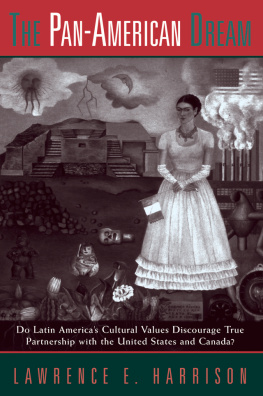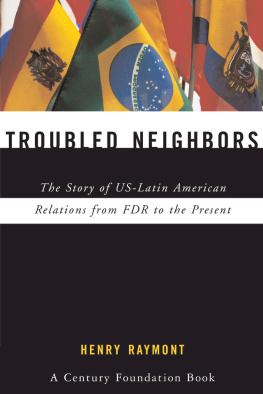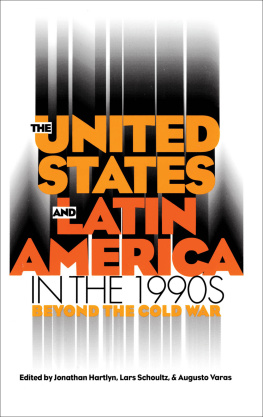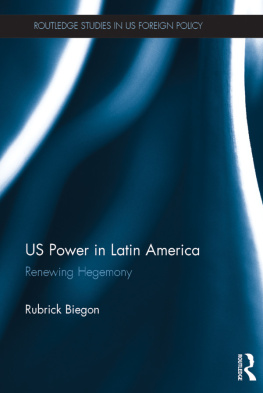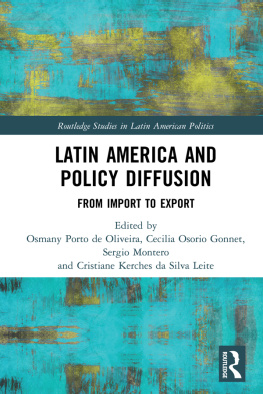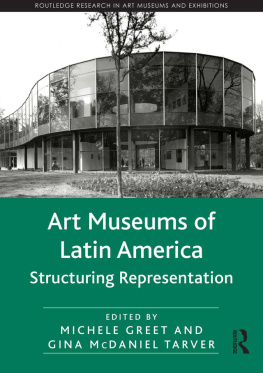About the Authors
Mark T. Gilderhus was a specialist in U.S. military and diplomatic history and a former president of the Society for Historians of American Foreign Relations. After teaching at Colorado State University for twenty-nine years, he became Lyndon Baines Johnson Chair at Texas Christian University in Fort Worth. He wrote several books, including History and Historians: A Historiographical Introduction (1996) and Diplomacy and Revolution: U.S.-Mexican Relations under Wilson and Carranza (1977). He earned degrees from Gustavus Adolphus College and the University of Nebraska. Professor Gilderhus died in 2015.
David C. LaFevor is assistant professor of history at University of Texas, Arlington. He earned a BA degree in Latin American studies from Rhodes College and a PhD in history from Vanderbilt University.
Michael J. LaRosa is associate professor of history at Rhodes College. He holds a BA degree in international relations from George Washington University and a PhD in history from the University of Miami.
Acknowledgments
ACKNOWLEDGMENTS TO THE FIRST EDITION (2000)
While pursuing this project, I accumulated more debts to friends and colleagues than I can possibly acknowledge. I owe special thanks to Richard M. Hopper, vice president and general manager of Scholarly Resources, for his patience and enthusiasm. Also I am grateful for the friendship, good counsel, and hilarity of William H. Beezley of the University of Arizona and Judith Ewell of the College of William and Mary, the series editors. We go back many years. Don Coerver, former History Department chair, and Michael McCracken, dean of the College of Arts and Sciences at my new base, Texas Christian University, allowed me the time and opportunity to complete this book. Most significant, my wife, Nancy, urged me in times of lethargy to get the damn thing done and accepted some wrenching but happy changes in our personal lives during the final stages. Of course, I alone have responsibility for errors and misconceptions.
Mark Gilderhus
ACKNOWLEDGMENTS TO THE SECOND EDITION (2017)
First and foremost we would like to thank Susan McEachern of Rowman & Littlefield Publishers, Inc. She offered us the opportunity to update and revise Professor Gilderhuss 2000 text. Professor Bill Beezley supported the project. At the University of Texas at Arlington, the Center for Mexican American Studies and the History Department provided important research support. At Rhodes College, dean Milton Moreland offered funding for research. Lance Ingwersen, at Vanderbilt, reviewed an early prospectus and offered advice. Mr. Weldon (Tat) Whitley provided technical support at Rhodes College. Timothy Garton worked with us for the duration of the project as researcher and editor; he helped compile the bibliography and wrote the final index. Photographer Bill LaFevor helped with photo selection and cover design. Paul Angelo assisted with research as the project neared completion. We appreciate the comments and excellent advice of the reviewers who supported this project both at the initial prospectus and final manuscript stages.
David C. LaFevor and Michael J. LaRosa
Chapter One
Expansion, Empire, and Intervention, 18891913
The Modern Age in diplomatic relations between the United States and the countries of Latin America began in 1889 at the First International American Conference. During the opening ceremonies on October 2 in Washington, DC, secretary of state James G. Blaine established a central theme by affirming high purposes and common interests. According to his hyperbolic formulation, no conference of nations ever before had assembled to contemplate the possibilities of a future so great and so imposing. Blaine wanted to advance a close acquaintance with Latin Americans through peace and trade and to establish what he called that common confidence on which all international friendship must rest. He also placed his countrys wealth and power on display. On the following day most of the seventy-three delegates embarked on a 5,000-mile, 42-day railroad journey through New York, New England, and the industrial heartland into the Midwest, at the conclusion of which the diplomatic work got under way in the nations capital.
Blaine presented an assortment of proposals. He called for the creation of a formal arbitration system to settle disputes and a customs union to increase trade. He also recommended the adoption of convertible silver currencies and other improvements in customs regulations, steamship travel, copyright laws, and extradition arrangements. Although well intended in his own view, Blaines initiatives produced controversy because Latin Americans mistrusted his motives and disliked the implications. This wariness was not a reaction to Blaine alone, but was the product of Latin American experiences of U.S. expansionism throughout the nineteenth century. At the expense of their southern neighbors, especially Mexico, the United States had forged its manifest destiny. Washington politicians had long coveted control over Cuba for a variety of geopolitical, economic, and nationalistic motives. Clearly, the
Although something of a disappointment for Blaine, this first modern Pan American conference nevertheless anticipated future directions in the U.S. foreign policy by signaling a transition from the Old to the New Diplomacy. Benjamin Harrisons administration from 1889 to 1893 played an important role in this process. Harrison, a modernizer in foreign policy, was the first president in the postCivil War era who attempted to coordinate the strategic, diplomatic, and economic factors of United States foreign policy. Beginning in the late 1880s the United States entered a more aggressive and expansionist phase and reached out into the world in an increasingly determined and deliberate fashion. To explain the change, historian Robert L. Beisner invokes Thomas S. Kuhns conception of a paradigm shift. Defined as a constellation of beliefs, values, and perceptions, a paradigm constitutes a way of seeing the world. In this instance the change altered the manner of thinking about and executing American foreign policy. Among other things, it moved diplomatic practice away from the reactive, improvisational style so characteristic of the immediate postCivil War era and toward a more systematic, expansive approach.
LEGACIES AND TRADITIONS
During the era of the New Diplomacy, Latin America became more important to the United States than ever before. In previous times the policy makers had taken only a limited, sporadic, and incidental diplomatic interest in the southern regions beyond Mexico, Cuba, and Central America. To be sure, groups of merchants, shippers, and political leaders periodically discerned opportunities for expanding overseas trade, but such ambitions had difficulty overcoming the distances imposed by geography, language, and culture. During colonial times the inhabitants of the two Americas displayed scant knowledge and awareness of each other outside those contentious border zones of Florida and Louisiana and in the sporadic battles over imperial control of the Caribbean.
The gap narrowed for a time during the independence era. As the first people to break free from colonial control, U.S. citizens perceived themselves as a republican vanguard, a model and an inspiration for others; they regarded the Spanish American rebellions against the mother country as emulations of their own example. Such ethnocentric responses somewhat
Conceptions of realpolitik more than ideology guided official U.S. responses during the wars of the French Revolution and later those of Napoleon. Under president James Madison the U.S. government occasionally expressed sympathy for the independence movements but otherwise assumed a neutral stance. Mainly, Madison wanted to avoid provocative displays toward Spain at a time of dangerous European complexities. Relations with France and Great Britain took priority before the War of 1812. Impatient advocates of Latin America, such as congressman Henry Clay of Kentucky, called for diplomatic recognition to win over the new regimes, sustain republican solidarity, and advance commercial opportunity, but U.S. policy makers concentrated on European concerns. After the War of 1812, secretary of state John Quincy Adams successfully resolved outstanding difficulties with Britain and Spain through complicated negotiations over boundaries along the northern and southern frontiers. Meanwhile, triumphant Latin American revolutionaries achieved independence and invited formal diplomatic ties. Insisting upon proper guarantees of order and responsibility, the United States under president James Monroe responded by extending diplomatic recognition to Mexico in 1822, the first country to do so. Recognition followed for Brazil and the Central American Confederation in 1824 and for most of the other countries during the next few years. Haiti, an exception, had to wait until 1862. As an independent nation created through revolution by the descendants of enslaved Africans, Haiti, for reasons of race, experienced isolation in a world dominated by white authority.


